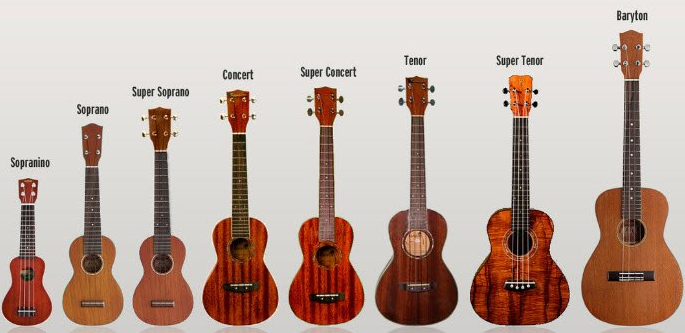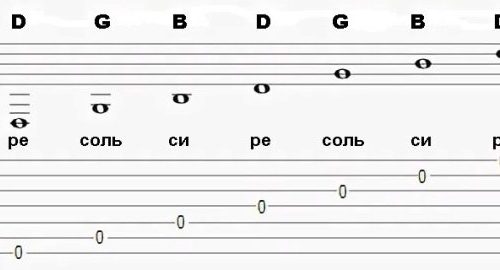
How to learn to play Ukulele
Contents
Ukuleles are solid advantages. It is lightweight, does not connect to the network: it will fit in a hiking backpack, cheer at a party. The miniature guitar was adored (and adored!) by professional musicians: Tyler Joseph (Twenty One Pilots), George Formby and George Harrison from the Beatles. At the same time, learning to play the ukulula is not at all difficult. Take 5 minutes to read our guide: success guaranteed!
This is interesting: the ukulele is a Hawaiian 4-string guitar. The name is translated from Hawaiian as “jumping flea”. And all because the movement of the fingers during the game resemble the jumping of this insect. The mini-guitar has been around since the 1880s, and gained popularity through touring Pacific musicians in the early 20th century.
So how do you get started playing the ukulele? Proceed step by step:
- choose the right tool;
- learn how to set it up
- master the basic chords;
- practice playing styles.
All this – further in our article.
How to learn to play the ukulele, stage number 1: choosing an instrument
There are 5 types of mini guitars that differ in sound and size:
- soprano ukulele – 55 cm;
- ukulele tenor – 66 cm;
- baritone ukulele – 76 cm;
- ukulele bass – 76 cm;
- concert ukulele – 58 cm.
Soprano mini guitars are the most popular. For beginners, they are well suited for mastering the basic styles of the game. Learn to play the soprano – you won’t have any problems with other types. Let’s consider two specific models.
Ukulele FZONE FZU-003 (soprano) is a basic and very budget instrument with good strings. The body of the mini-guitar, as well as the tailpiece, are made of laminated basswood, the tuning pegs are nickel-plated. No-frills option: just what you need for a beginner.
The guitar is more expensive, but also better in quality – the PARKSONS UK21Z ukulele . A clear-sounding instrument that stays in tune very well. “Plus” to everything – a solid body (mahogany, spruce, rosewood) and cast chrome pegs. Option, as they say, for centuries.
Tip: Feel free to ask for advice. The specialists of our online store will be happy to tell you which ukulele is better to watch.
How to learn to play the ukulele, stage number 2: tuning
Do you already have a tool? Alright, time to set it up. Today we will talk about two systems:
- standard;
- guitar.
Standard ukulele tuning differs from guitar tuning in that the lowest open string is not the lowest note. At the same time, the sound of the instrument at the 5th fret completely coincides with the sound of the guitar.
So, we adjust the sound of the strings from the top to the bottom according to the notes:
- G (salt);
- From to);
- E (mi);
- A (la).
Tuning a ukulele to a guitar tuning is as follows:
- E (mi);
- B (si);
- G (salt);
- D (re).
The sound of the instrument should match the sound of the first four strings of a regular guitar.
If we are asked how to quickly learn to play the ukulele, we answer: use the standard system. That will be the easiest. Therefore, further – exclusively about him.
How to Learn to Play the Ukulele Step 3: Basic Chords
As with the regular guitar, there are two types of chords that can be played on the ukulele: minor and major. In key notation, the letter “m” is minor. Therefore, C is a major chord, Cm is a minor.
Here are the basic ukulele chords:
- From (to) – we clamp the fourth string (with the ring finger);
- D (re) – hold the first string (second fret) with your middle finger, and the second on the 2nd with the ring finger, the third on the 2nd with the little finger;
- F (fa) – the 2nd string on the first fret is clamped with the index finger, the first on it – with the ring finger;
- E (mi) – the fourth string on the 1st fret is clamped by the index finger, the first on the 2nd – by the middle, the third on the 4th – by the little finger;
- A (la) – the third string on the 1st fret is clamped with the index finger, the first on the second – with the middle;
- G (sol) – the third string on the second fret is clamped with the index, the fourth on the 2nd – middle, 2 on the 3rd – nameless;
- In (si) – the index finger pinches the 4th and 3rd strings at the second fret, the middle finger – the second at the third, the ring finger – the 1st at the fourth fret.
Tip: before learning how to play specific chords, learn how to play the strings with your fingers, get used to the instrument. Take at least 1-2 days to get used to it. Haste in this matter is a bad helper.
How to hold a ukulele in your hands: support the neck with your left hand, pressing it between your thumb and the other four fingers. Pay due attention to posture: the guitar should be pressed with the forearm, and its body should rest against the crook of the elbow. It is very easy to check if the tool is correctly positioned. Remove your left hand. If the ukulele remains fixed and does not budge, you have done everything correctly.
How to Learn to Play the Ukulele Step 4: Playing Styles
You can play in two ways: fight and bust. Here the mini-guitar is no different from the classical one.
Fighting music involves a pinch of fingers or one index finger. Strikes down – with the nail of the index finger, strikes up – with the pad of the finger. You need to hit the strings just above the socket. The blows must be measured, rhythmic, sharp, but not too strong. Try to combine different variations of chords, achieving a sound that is pleasing to your ear.
The game of brute force has another name – finger picking. With this style, it is important to attach a certain string to each finger and strictly adhere to this order:
- thumb – the thickest, 4th string;
- index – third;
- nameless – the second;
- little finger – the thinnest, 1st string.
When playing the ukulele by fingering, all sounds should be even, flowing smoothly. And also – to have the same sound in strength. Therefore, many musicians believe that this style is quite difficult to learn.
How to learn to play the ukulele from scratch: final tips
We have dealt with the basic theory. But we want to warn you right away: you don’t need to look for ways to learn how to play the ukulele in 5 minutes. It’s simply impossible. The tool is mastered quickly, but not instantly. By exercising regularly, in a week or two you will notice the first results. Here are some final tips to make learning more effective and enjoyable:
- Set aside a fixed time for classes. For example, an hour every day. Stick to this schedule and don’t skip your workout. After all, it is very important to “fill your hand” in the initial stages. Who knows, maybe after a year or two of hard work you will need a concert guitar .
- To begin with, hone the chords. No need to immediately try to learn entire compositions – it is difficult and ineffective. To play basic melodies in the future, it is enough to memorize the elementary chords from our article.
- If the melodies – then only those that you like. Now you can find the tablature of any song, so there are no restrictions. And playing your favorite tunes is always doubly pleasant.
- Work on pace. It is the right pace that is the basis of a beautiful, melodic and correct game in all respects. A regular metronome will help you hone it.
- Don’t forget about inspiration. Indeed, without it, as without the most important ingredient, certainly nothing will work.
That’s all you need to know. Good luck and happy learning!





